In recent years, trampoline parks have been growing in popularity across America and Europe. However, while people have become more aware of the joys of commercial trampolining, the industry still struggles to shed it’s ‘novelty’ status.
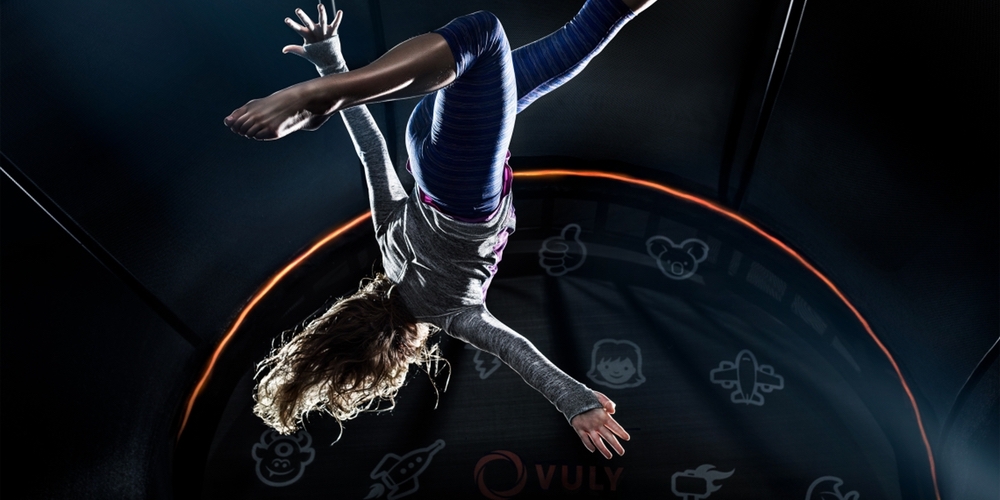
In recent years, trampoline parks have been growing in popularity across America and Europe. However, while people have become more aware of the joys of commercial trampolining, the industry still struggles to shed it’s ‘novelty’ status.

Unlike ten-pin bowling, swimming or the cinema, trampoline parks have yet to earn the brand recognition or populist following needed to pull in recurring customers.
As trampoline parks are an offline business, they appeal mostly to local consumer groups, this makes for a limited customer base which can be burned through quickly once the locals have had their fun. In the long term, this can drastically increase a trampoline park’s marketing spend and threaten to end the business before it has had a chance to begin.
To help remedy this issue, before approaching contractors park owners need to focus on and consider their trampoline park’s design in order to create an engaging business which customers will want to keep returning to.
The flexible and multi-functional element of a trampoline park’s design is a major factor that will determine whether the business will persevere and grow in the initial months. Trends and novelties can flame out quickly, so a park’s ability to cater to all needs of its customers is important in encouraging brand loyalty and generating multiple visits.
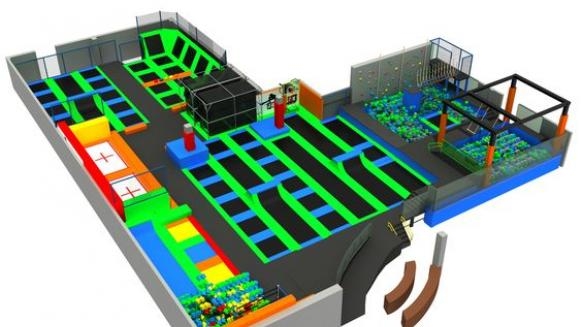
Before starting your trampoline park layout, you first need to assess the space you have to work with. Deciding you’d like three trapeze swings, but then realizing you don’t have enough floor space for the airbags will only waste time, leave your vision in pieces and frustrate you.
Be aware of the space, volume, and dimensions of the property you have purchased and then build your expectations around how you can manipulate that space.
Here are some recommendations for filling your space according to the International Association of Trampoline Parks:

Your trampoline park plan will be catering to the needs of your customers, so it makes sense to delve into who you think, or who you want, to come to your park and tailor your design to their fun-filled needs.
You don’t have to make your park universal: some of the best trampoline park designs specialize in a certain niche, like adult trampolining, family trampolining, or fitness.
If you don’t know what your ideal customer would like from your establishment, then go out and ask the people who embody the buying personas you’re trying to attract. Set up a simple questionnaire with google forms and then post on various Facebook groups to receive insightful feedback on what to include in your trampoline park design.
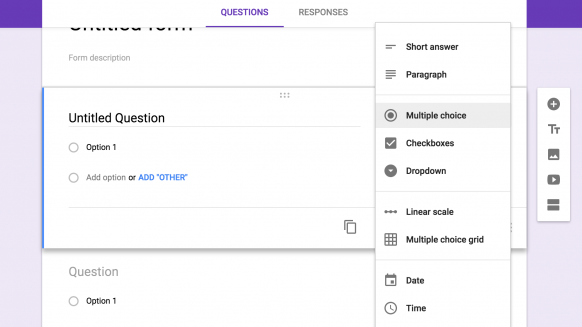
Persona Ideas for your Trampoline Park
Having these personas in mind will help you with the initial layout of your trampoline park. Think about what their biggest fear might be when trampolining and what type of experience they are expecting from your establishment.
For example, if you want to entice pro trampoliners to come to your park, you will need some high-quality trampolines so they can get extra height to do big tricks. However, this can be intimidating for younger kids and beginners, so in your trampoline park design it might be best to position the skills zone toward the back of the building. That way incomers can spectate the pro tricks and feel incentivized to join in too.
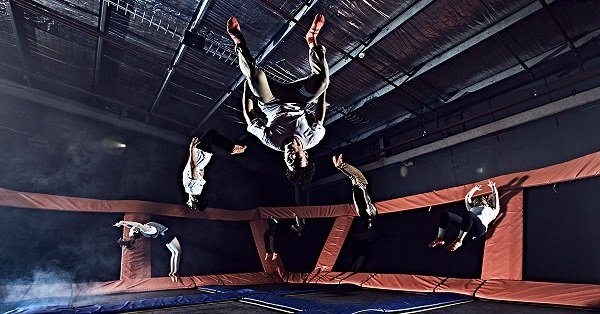
Pro-tip: First-time potential customers might have a few concerns when it comes to the safety of trampoline parks. To ease fears ensure you market your trampoline park’s sections, who they are for and what can be done there on your website, this will help your audience feel more reassured and confident to purchase entry to your park.
After getting to grips with what you have and who your park will be for, you can begin filling your trampoline park design with ideas. It is important that your trampolining zones have something suitable for all age ranges and fitness types.
The concepts of each zone in your trampoline park layout will be an important factor when consumers book your facility, so try to make these concepts as inventive as possible.
Here is a list of trampoline park zone ideas to make your facility a memorable experience for your new customers.
Adding a sports zone can serve multiple purposes. Not only will game duration fill your participants time slots, but providing tangible competitive activities will keep your customers from getting bored of “just” bouncing around your facility. Offering segmented game times in a sports zone can also keep other zones less congested for structured periods of time.
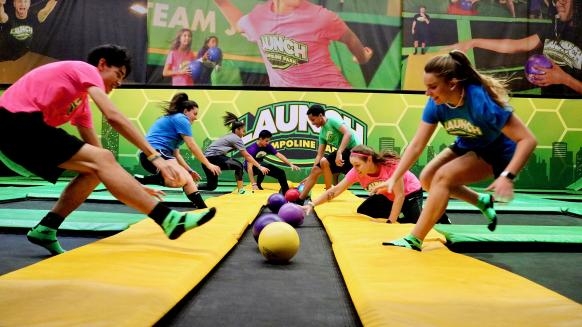
In addition to this, sports games provide a high element of interaction and teamwork for customers, giving an added social and collaborative benefit.
Trampoline sport ideas:
Nowadays people are becoming more aware of their wellness, encouraging them to seek new fitness experiences. Trampolines make exercise fun and they are incredibly effective for building stamina while also improving motor skills and coordination.
In fitness, treadmills, ellipticals, and spin bikes have become synonymous with the dull monotony of the gym. Trampolining, on the other hand, is exciting because of its childish, unique and challenging appeal.
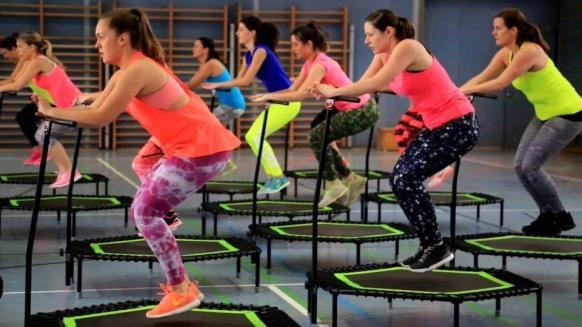
By adding a trampoline fitness zone to your park design, you can cater to fitness consumers as well as recreational fun seekers. Unlike recreational customers, fitness customers could prove more valuable to your park by first expanding your client base and second, by encouraging fitness seekers to keep returning to your trampoline park for weekly classes.
Pro Tip: Incentivize trampoline park bookings and sign-ups to your facility’s fitness classes by allowing your customers to browse time slots, reserve and book online with a client portal which syncs to your back office management software.
For those with more skills, no fear, or both, you can design an area in your trampoline park where fun tricks can be performed.
Most people have watched the popular reality show Ninja Warrior at some point or another and thought, ‘I could do better than that!’ Now you can put them to the test by installing an extreme obstacle course in your trampoline park.
With safety nets and soft foam mats covering the floors, participants have to push themselves through a series of unusual and grueling obstacles.
Such courses typically consist of:
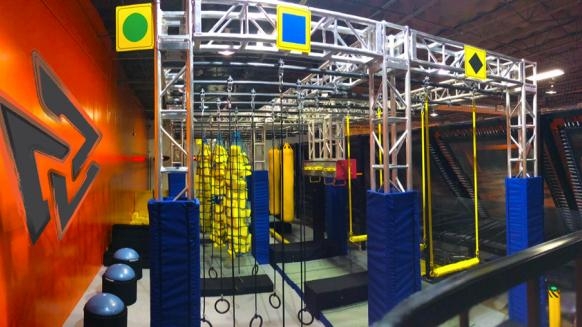
With a ninja course, customers can experiment with their own endurance and coordination. In addition, you can create your own ‘Trampoline Ninja’ scoreboard where participants can compete against one another for a more interactive element.
In this area, you can place giant soft airbag landings directly next to the trampolines in your park design, so customers can practice their front flips, back flips, twists and landings in safety. Air bags are great for softening hard landings, allowing customers to try more moves in a risk-free way.
If you don’t think that is thrilling enough, in this area you can add more airbags dedicated for all manner of aerial swings or trapezes, allowing your more skilled customers to push their acrobatic skills.
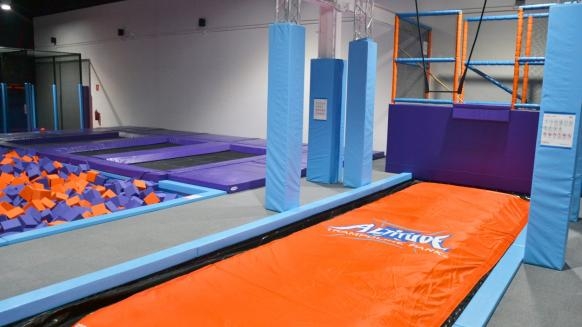
This one's for the parkour wannabes and enthusiasts who walk through your door. By setting up a zone with padded walls on each side of the trampoline areas, customers can be free to jump, bounce and walk vertically on the walls.
Having special walls, swings and airbags will give your skilled customers an opportunity to push themselves and show off their talents, this in turn can act as a fun show for other customers to spectate when they walk in through your doors.
Pro tip: Installing a vending machine for cold drinks can be very effective in the sport and skilled trampoline zones.
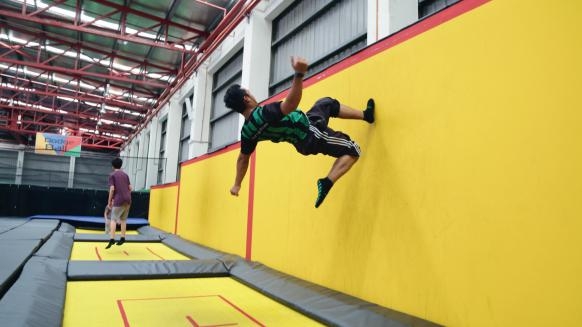
Kids are filled with endless energy and curiosity therefore, trampoline parks can satiate them with a world of adventure, excitement, and athletic possibility. It is a given that children will enjoy your park, but trampolining is also an opportunity for kids learn social and physical skills, too. Exactly how well your park can benefit the development of kids will depend on the features you choose to have in your design.
Kids usually spend all day interacting with other children at school, and typically these kids will be from the same background. Playing in a trampoline park offers opportunities for children to make new friends from differing backgrounds. Adding interactive games to your kid's zone can further encourage skills such as co-operation, teamwork and problem-solving.
Trampoline features for social development include:
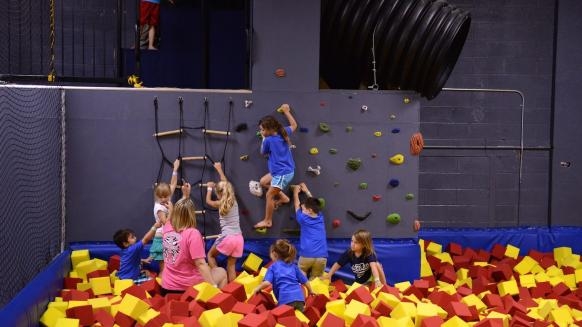
Trampolining is also an effective and safe way for children to hone their coordination, core strength and balance skills. The soft play element allows kids to roam and explore their fitness without fear of injury. This, in turn, also encourages exercise to become a habit for the children.
Trampoline features for physical development include:
As the most populated and stimulating area of your facility, safety measures will need to be keenly applied too. Ensure that within your kid’s zone there is a seperate section for toddlers (aged 1-5) to reduce the risk of injury from older, boisterous children.
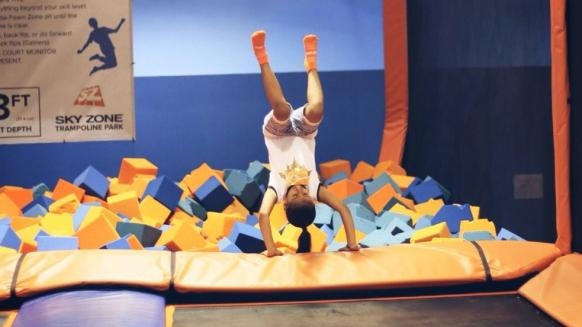
Pro tip: For kids, trampoline parks can look like vast mazes. If possible, locate the kids zone close to the bathrooms and at the front of the facility. This way parents and park monitors can watch the children more easily, and the kids will have the most convenient route to the bathrooms.
It sounds a little strange to have areas not dedicated to trampolining within a trampoline park, but these sectors are incredibly important in creating a holistic recreational experience that can appeal to the majority of people. Not only will these areas encourage visitors to return, but it can also add to your park’s secondary spend, too.
Just like at the cinema and at theme parks, part of the experience is eating some fun snacks you wouldn’t usually get at home. With customers burning a lot of energy in your facility, you can encourage trampoliners to stay longer by providing refreshments to help them sit, relax, and refuel.
This zone might be especially appealing for children’s birthday parties and young families by as it helps you to provide a fun, convenient day out all under one roof, thus upping customer satisfaction and increasing word of mouth referrals.
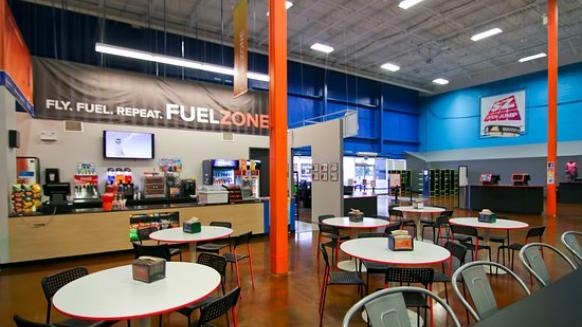
Of course, it is wise to enforce a waiting period before customers take to the trampolines again to avoid uncomfortable cramps or unfortunate vomiting.
Pro tip: To ensure efficient management of your whole trampoline park, choose a facility management software which can give you a reliable and informative point of sales system.
PerfectGym’s intuitive point of sale software not only allows team members to complete transactions easily, the system can also generate reports on to total products individual team members sold in a day. Our inventory tool will remove the hassle of manual inventory counting and ensure your park is always well stocked.
Safety is important, so make a dedicated space for your staff to explain the major safety rules to the children away from the ruckus of the trampoline park. Having a space for safety onboarding will also help embolden customers to ask questions about any concerns or rules they are unsure of.
Having such a room can add a higher element of professionalism to your customer experience and this will help the shyer members of a group feel more confident and looked after as they take to your trampoline park for the first time.
For any customers over the age of 5, rest zones will be paramount. Trampolining can be fun, silly and a great source of fitness; however, having customers fully exert themselves within the first 10 minutes of their 2-hour slot will make the whole experience seem like a waste of money to them.
Ensure the great customer experience follows participants even when they are catching their breath. Installing a comfortable cool down zone complete with wi-fi, couches and tables will allow your customers to take a minute and get ready for more trampolining. It gives people the freedom to enjoy your facility the way they want to. This way you widen your client base by appealing to many people with differing levels of fitness.
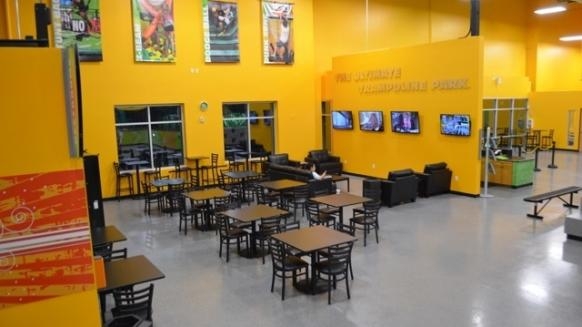
Gain an edge in your trampoline park by creating a wide array of entertainment options, a big way you can achieve this is creating an arcade zone.
Pool, whack ‘ems, coin machines and gaming are all classic elements of an arcade. Inexpensive for customers to use and endless hours of fun, arcade games appeal to big and small kids alike.
Having such a zone in your facility allows you to offer a spectrum of entertainment. Trampolining is a dynamic, thrilling and unique sport. And as discussed earlier, rest zones are needed to balance out the energy debt they induce in customers. Arcade zones are, therefore, the go-to for when customers tire of trampolining but still crave stimulating experiences.
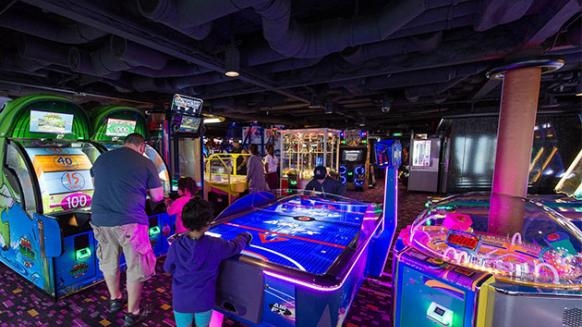
Trampoline parks are great for groups of people to come, bond and have a fun-filled day. With special ‘party’ rooms to your trampoline park layout, you can drive more business to your park through incentivizing events bookings.
Including parties and team building events in your trampoline park’s repertoire is infinitely more valuable to your business as every event you host is an opportunity to market your park to the others in the group. If you can provide groups with an exclusive and unique party experience, you can create dozens of brand advocates. And in the events industry, word of mouth referrals are incredibly powerful: According to a study done by Nielsen, 92% of people trust recommendations from friends and family over any other type of advertising.
Designated rooms help give customers a feel of exclusivity as well as allowing the whole group a place where they can come together as a group.

When it comes to opening a trampoline park, it is guaranteed that the park will garner a lot of buzz and excitement within the local area.
However, to maintain that interest, trampoline park owners need to set themselves up for success from the get-go by approaching their trampoline park plan in a way that will serve real entertainment needs of customers, rather than quenching the superficial curiosity of locals.
The trampoline park layout, at its heart, needs to be multifunctional. People use recreational facilities such as bowling alleys, leisure centers, and cinemas in order to reduce stress, spend time with friends and be hosted.
Creating a layout which caters to needs such as fun, interaction, refreshments, trampoline guidance, and relaxing will reinforce your brand as a holistic means for customers to fulfill their recreational needs.
Discover how our innovative solutions can elevate your business. Request a demo today and see the difference firsthand. Let's grow, together!
